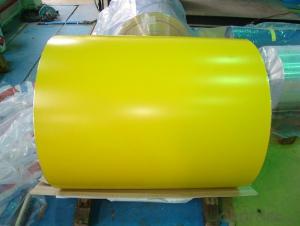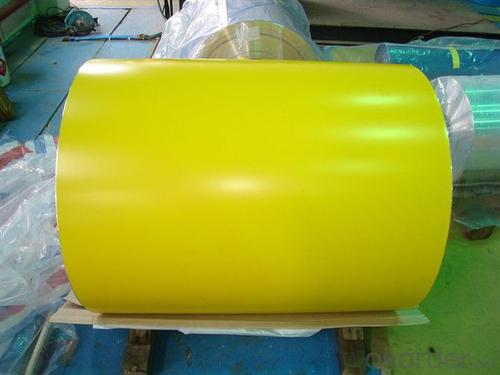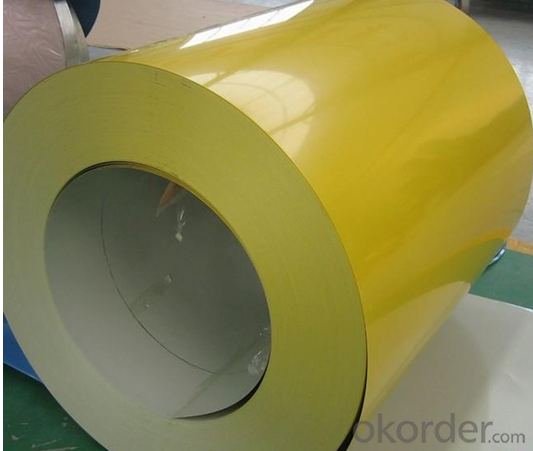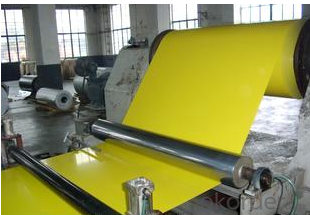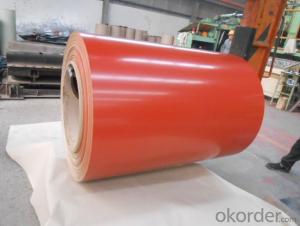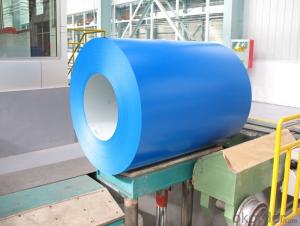Color Coated Galvanized Steel Coil PPGI in Yellow
- Loading Port:
- Shanghai
- Payment Terms:
- TT OR LC
- Min Order Qty:
- 50 m.t.
- Supply Capability:
- 10000 m.t./month
OKorder Service Pledge
OKorder Financial Service
You Might Also Like
1.Structure of Pre-painted Galvanized/Aluzinc Steel Coil Description
With GI (aluzinc) as base metal, after pretreatment (degrease and chemical treatment) and liquid dope with several layers of color, then after firing and cooling, finally the plate steel is called pre-painted galvanized (aluzinc) steel. Pre-painted galvanized steel is good capable of decoration, molding, corrosion resistance. It generally displays workability, durability and weather resistance.
2.Main Features of the Pre-painted Galvanized/Aluzinc Steel Coil
• Excellent corrosion resistance
• Excellent weather resistance
• Capability of decoration, molding, corrosion resistance
• Workability, durability
• Excellent heat resistance performance
• High strength
• Good formability
• Good visual effect
3.Pre-painted Galvanized/Aluzinc Steel Coil Images
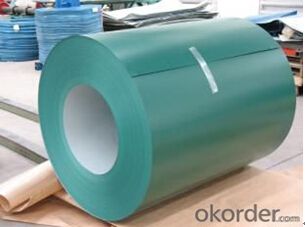
4.Pre-painted Galvanized/Aluzinc Steel Coil Specification
Quality standar: JIS G3312 CGCC & CGLCC
Hardness of P: Both soft and hard quality are available
Surface finish: with or without protect film
Thickness : 0.14-1.20 mm
Width : 914mm, 1000mm, 1220mm and 1250mm, thickness 600-1250mm is available
Finish by coil or sheet: Both sheet and coil are available
8Zinc coating: 60-275G/M2, both sides
Paint thickness for top side : 5 micron primer + (10-20) microns modified polyester, green color.
Paint thickness for back side: (5-10) microns Epoxy
Weight per coil: 4-6 tons, also can be upon customer's requirements
Max loading weight in one 20ft container : 25 tons generally
5. FAQ of Pre-painted Galvanized/Aluzinc Steel Coil
We have organized several common questions for our clients,may help you sincerely:
1. What is the minimum order quantity ?
Our MOQ is 50mt for each size. And we will consider to give more discount if you make big order like 1000 tons and more. Further more, the more appropriate payment term your offer the better price we can provide.
2. How long can we receive the product after purchase?
Usually within thirty working days after receiving buyer’s advance payment or LC. We will arrange the factory manufacturing as soon as possible. The cargo readiness usually takes 15-25 days, but the shipment will depend on the vessel situation.
3. How to guarantee the quality of the products?
We have established the international advanced quality management system,every link from raw material to final product we have strict quality test;We resolutely put an end to unqualified products flowing into the market. At the same time, we will provide necessary follow-up service assurance.
- Q: Many gerber knives are made out of what gerber calls high Carbon steels and I was wondering if anyone knew exactly what is this mysterious steel.
- The carbon content of the knife is done during the smelting process.For instance a knife that has a high carbon content will keep an edge much longer than one with a lower content. It is tricky because too much will cause the knife to be brittle and break easily. Annealing is also part of the process of knife making.
- Q: How are steel coils used in construction?
- Steel coils are commonly used in construction for a variety of purposes, such as creating structural frameworks, reinforcing concrete, and manufacturing various building components like beams, columns, and trusses. The coils are unrolled and cut to specific dimensions, allowing them to be easily shaped and welded into various structural elements. This versatile material provides strength, durability, and flexibility, making it an essential component in constructing buildings, bridges, and other infrastructure projects.
- Q: what is the difference between stainless steel 304 (AISI 304) and stainless steel 310 (AISI 310) COR-TEN A
- Weathering steel will rust, but the rust will be adherant and not flake off and be replaced by new rust. Therefore once it rusts it will pretty much stop rusting any more. One (severe) down side is that anything around it will be streaked with rust stains and it will look awful. Some bozo with the Texas Department of Transportation designed a number of freeway interchange overpasses here in Houston using Cor-Ten steel and all of the concrete supports are streaked with red rust stains and it looks like hell. Cameron built an office building here in Houston with a Cor-Ten facade and it is streaked with rust too. They should have gone ahead and spent the money and painted them, but they didn't.
- Q: How do steel coils contribute to energy efficiency in transportation?
- There are several ways in which steel coils help improve energy efficiency in transportation. To begin with, steel coils are lightweight and have a high strength-to-weight ratio. This means that they require less steel material to carry the same load compared to other materials like wood or concrete. As a result, the overall weight of the transport vehicle is reduced, leading to lower fuel consumption and emissions. Furthermore, steel coils are extremely durable and can withstand harsh transportation conditions. They are highly resistant to corrosion, impact, and fatigue, ensuring a longer lifespan for the transport vehicle. This durability reduces the need for frequent repairs or replacements, resulting in reduced energy consumption and material waste. Moreover, steel coils are easily handled and transported. Due to their compact and standardized size, they can be effortlessly loaded and unloaded from trucks, trains, or ships. This efficiency in handling reduces the time and energy required for loading and unloading operations, ultimately increasing overall transportation efficiency. Additionally, steel coils can be efficiently stacked and stored, maximizing the utilization of available space in transport vehicles. This reduces the number of trips needed to transport the same amount of goods, resulting in less energy consumption and lower transportation costs. Lastly, steel is a highly recyclable material. At the end of their life cycle, steel coils can be easily recycled and used to produce new steel products. This reduces the demand for raw materials and the energy required for manufacturing new products, thereby contributing to overall energy efficiency in transportation. In conclusion, steel coils play a crucial role in enhancing energy efficiency in transportation. Their lightweight, durable, easy-to-handle, and recyclable nature leads to decreased fuel consumption, lower emissions, reduced maintenance needs, efficient use of space, and minimized material waste. All of these factors contribute to a more sustainable and energy-efficient transportation system.
- Q: How are steel coils used in the production of transportation equipment?
- Steel coils are used in the production of transportation equipment, such as automobiles, ships, and trains, to create various structural components. These coils are typically shaped and formed into parts like chassis, frames, bodies, and panels, providing strength, durability, and stability to the vehicles. Additionally, steel coils can be used in the manufacturing of wheels, axles, and suspension systems, ensuring reliable performance and safety in transportation equipment.
- Q: How are steel coils used in the production of shipbuilding materials?
- Steel coils are used in shipbuilding materials as they provide a versatile and durable solution. They can be processed into various shapes and sizes, including plates, beams, and sections, which are essential components for constructing ships. The coils are often cut and shaped to fit specific design requirements, offering strength and structural integrity to the ship's framework. Additionally, the coils are utilized in the fabrication of various shipbuilding components, such as hulls, decks, bulkheads, and superstructures, ensuring the vessels' resilience and stability.
- Q: Can steel coils be coated with polymer?
- Yes, steel coils can be coated with polymer.
- Q: the difference between the original steel and mild steel from percentage of carbon
- Carbon steel includes mild steel. Mild carbon steel(as it is referred to) contains .05 - .29% carbon. Medium carbon steel is from .30 - .59%. High carbon steel is from .60 - .99%. Ultra high carbon steel is from 1.00 - 2.00%. Steel is considered carbon steel up to 2.1%. Past that it is considered cast iron. The more carbon in the steel the harder and less ductile and maleable it is and also the more brittle it is. The less carbon in the steel more it will bend and shape without breaking. So in essence carbon adds strength but takes away from its elasticity. If you are interested in this subject an interesting source is swordmaking where hardness(carbon content) is crucial. The information behind this subject is pretty infinite.
- Q: How are steel coils protected against UV radiation?
- Steel coils are protected against UV radiation through a process known as coil coating. Coil coating involves applying a protective layer of paint or coating to the surface of the steel coil. This coating acts as a barrier between the steel and UV radiation, preventing direct exposure of the metal to the harmful effects of the sun's ultraviolet rays. The protective coating used for steel coils is specially formulated to provide excellent resistance against UV radiation. It typically contains pigments and additives that are designed to absorb or reflect UV light, reducing the amount of radiation that reaches the steel surface. Furthermore, the coating is applied in multiple layers to ensure maximum protection. The first layer, known as the primer, enhances adhesion to the steel surface and provides additional corrosion resistance. The subsequent layers, such as the base coat and topcoat, offer improved durability and UV resistance. In addition to the coating itself, the steel coils can be further protected against UV radiation by storing them in shaded areas or using covers to shield them from direct sunlight when stored outdoors. This additional precaution helps minimize the exposure of the coated steel coils to UV radiation, thereby prolonging their lifespan and maintaining their appearance. Overall, the combination of a high-quality protective coating, proper storage, and handling practices ensures that steel coils are effectively shielded against the damaging effects of UV radiation, allowing them to maintain their structural integrity and aesthetic appeal over an extended period of time.
- Q: How do steel coils contribute to strength and durability in manufacturing?
- Steel coils contribute to strength and durability in manufacturing primarily due to their composition and structural properties. The tightly wound coils are made from high-quality steel, which offers excellent strength, rigidity, and resilience. This enables manufacturers to produce sturdy and long-lasting products, as the steel coils provide a solid foundation and structural integrity to various applications. Additionally, steel coils are often used in the construction of infrastructure, machinery, and automotive industries, where their durability and resistance to wear and tear play a vital role in ensuring the longevity and reliability of the final product.
Send your message to us
Color Coated Galvanized Steel Coil PPGI in Yellow
- Loading Port:
- Shanghai
- Payment Terms:
- TT OR LC
- Min Order Qty:
- 50 m.t.
- Supply Capability:
- 10000 m.t./month
OKorder Service Pledge
OKorder Financial Service
Similar products
Hot products
Hot Searches
Related keywords
